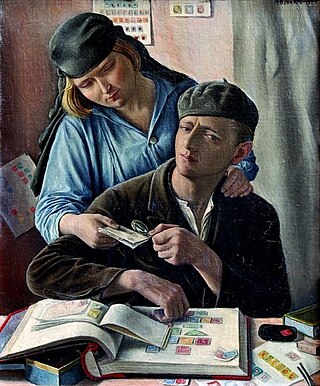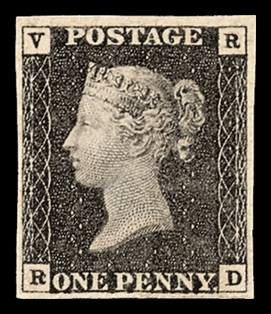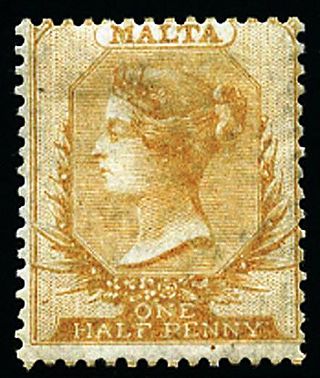This article needs additional citations for verification .(May 2009) |

Philatelic literature is written material relating to philately, primarily information about postage stamps and postal history.
This article needs additional citations for verification .(May 2009) |

Philatelic literature is written material relating to philately, primarily information about postage stamps and postal history.
Philatelic literature is held by stamp collectors and dealers, philatelic societies, and general and specialist libraries. The holdings of the British Library, for instance, are estimated at 30–35,000 works. [1]
Philatelic literature is generally divided into the following categories:

Perhaps the most basic sort of literature is the stamp catalogue. This is basically a list of types of postage stamps along with their market values.
The first stamp catalogue was published in France by Oscar Berger-Levrault on 17 September 1861 and the first illustrated catalogue by Alfred Potiquet in December 1861 (based on the earlier work).
The first catalogues in Great Britain were published in 1862 by Frederick Booty, [2] Mount Brown, [2] and Dr. John Edward Gray. [3] The first in the United States was The Stamp Collector's Manual by A.C. Kline (a pseudonym for John William Kline), also 1862. [4]
Some catalogues, like the Michel catalogue and various one-country catalogues, offer a great deal of information going beyond the basic properties of each stamp type.
Another common sort of book is the comprehensive "Stamps and Postal History" of a single country. These go beyond the basic date, denomination, and market price seen in the catalogues, explaining why particular stamps were issued, where and how they used, and more generally how the country's postal system worked in various periods.
The next level of specialization is remarkable both for the level of minutiae and the number of works that have been published. Specialists write monographs summarizing everything that is known about a single type of stamp - the history of its design, the printing process, when and where the stamp was sold to the public, and all the ways it was used on mail. If the stamps is particularly rare (the Inverted Jenny or the missionary stamps of Hawaii), the book may actually include a census of every single copy known to exist. As might be expected, the audience is small, and the print runs of these books are small too. Classic works out of print may be much-sought-after, sometimes even more than the stamps they are describing!
Other kinds of specialized work include comprehensive studies of postal usage in limited areas and times, perhaps mail in Montana Territory before it became a state, or mail from missionaries in Uganda before it became a British colony.

In addition to books, there are a great number of philatelic journals. The first stamp magazine was the Monthly Intelligencer from Birmingham, England, followed shortly by many others. [2] The journals and newsletters of clubs and societies also have an important role in philatelic literature. Many journals only run for a few numbers and then cease but they often contain information found nowhere else and therefore are valuable sources for philatelists.
Some popular philatelic periodicals are:
The scale and complexity of philatelic literature is such that it has its own journal, the Philatelic Literature Review, published quarterly by the American Philatelic Research Library.
There are also a number of libraries devoted solely to philatelic literature. (see link below)

Stamp collecting is the collecting of postage stamps and related objects. It is an area of philately, which is the study of stamps. It has been one of the world's most popular hobbies since the late nineteenth century with the rapid growth of the postal service, as a never-ending stream of new stamps was produced by countries that sought to advertise their distinctiveness through their stamps.

The VR official was one of three postage stamps introduced by the United Kingdom of Great Britain and Ireland in May 1840 for the pre-payment of postage. While the Penny Black and the Two Pence Blue were for use by the general public, as were the Mulready envelopes and letter sheets, the VR official was for use on official mail. In appearance the VR Official was the same as the issued Penny Black except that the Maltese crosses in the top corners were removed and replaced by the letters V and R, hence its common name.

A stamp catalog is a catalog of postage stamp types with descriptions and prices.

L.N. and M. Williams were a philatelic writing partnership made up of brothers Leon Norman Williams and Maurice Williams (1905–1976).

Sir Edward Denny Bacon was a British philatelist who helped with the enlargement and mounting of collections possessed by rich collectors of his time and became the curator of the Royal Philatelic Collection between 1913 and 1938.

Frederick John Melville was a British philatelist, prolific philatelic author and founder of The Junior Philatelic Society. He was also a founder in 1907 of the Philatelic Literature Society. Melville is a member of the American Philatelic Society's Hall of Fame and was a signatory to The Roll of Distinguished Philatelists in 1921.

Herbert L'Estrange Ewen (1876–1912) was a British stamp dealer and philatelist in Swanage, Dorset and later in Norwood, London who was an authority on railway stamps. According to Brian Birch, Ewen collected stamps at the age of ten and started his own firm, the H. L’Estrange Ewen company, on his thirteenth birthday.
Gary Sidney Ryan (1916–2007) was an eminent philatelist who specialised in the stamps and postal history of Hungary and later in revenue stamps.
David Richard Beech MBE was the curator of the British Library Philatelic Collections from 1983–2013. He is a fellow and past-president of the Royal Philatelic Society London (RPSL). In 2013, it was announced that Beech was to receive the Smithsonian Philatelic Achievement Award for outstanding lifetime accomplishments in the field of philately.

Herbert Edgar Weston, or H. Edgar Weston, was a stamp dealer in Stockwell, London, then Twickenham, who used the pseudonym Victor Marsh and who purchased Jean-Baptiste Moens' stock of philatelic literature after Moens' retirement in about 1907. Weston claimed to have the world's largest stock of philatelic literature for sale. He was also a prolific producer of philatelic covers using cut-outs from stamped to order postal stationery items. In 1907, Weston was a founder member of the Philatelic Literature Society.

Mount Brown was an early British philatelist and the compiler of only the second published stamp catalogue in the English language. Brown attended the City of London School and started to collect stamps in around 1860.

Frederick William Booty was an English artist from, who was also the author of the first postage stamp catalogue in English, and the first illustrated stamp catalogue anywhere.

The Crawford Library is a library of early books about philately formed between 1898 and 1913 by James Lindsay, 26th Earl of Crawford. By the time of his death in 1913, Crawford was thought to have amassed the greatest philatelic library of his time. Today, the library is part of the British Library Philatelic Collections.

The Halfpenny Yellow is the first postage stamp issued by the Crown Colony of Malta. Depicting Queen Victoria, it was only valid for local postage and it was originally issued on 1 December 1860. It was the only stamp issued by Malta for two and a half decades, and during this period various reprints were made with differences in colour shade, perforation and watermark. When control of Malta's postal service was transferred to the island's colonial government on 1 January 1885, the stamp was withdrawn and it was replaced by a set of definitive stamps.
Arnold Cartwright Waterfall was a philatelist who was a specialist in the stamps of Tibet. He wrote extensive on the subject and his articles appeared in Gibbons Stamp Monthly, the China Clipper, the Collectors' Club Philatelist, the China Philatelic Society Bulletin and The Philatelist. His The postal history of Tibet was written after thirty years of personal research and included the information that some Tibetan stamps were printed using house paint and that soot or boot polish were sometimes used to cancel stamps.

Hedwige Alma Lee FRPSL RDP was a Swiss-born naturalised British philatelist who specialised in the stamps of Switzerland and in topical collecting. She won large gold medals for her displays at Naba 1984, Stockholmia 1986, Hafnia 1987 and Finlandia 1988 and her collection was exhibited in the Court of Honour at PhilexFrance 1989 and New Zealand 1990. She signed the Roll of Distinguished Philatelists in 1991 and later became the only non-resident member of the Consilium Philateliae Helveticae. The Royal Philatelic Society London award the Lee Medal in memory of Alma and her husband Ron.

James Bendon is a stamp dealer, publisher, and philatelist who is an authority on specimen stamps. He wrote and published the first worldwide catalogue of Universal Postal Union specimen stamps and subsequently published philatelic books by authors such as Robson Lowe and James Negus.

Francis Hugh Vallancey was a schoolmaster, philatelist, philatelic author and editor, and dealer in philatelic literature. His business was destroyed during the London Blitz of 1941, but he rebuilt it after the war before ill health forced his retirement.

Henry Garratt-Adams was a British philatelist, philatelic publisher and dealer in philatelic literature based in Kinnersley Castle in Herefordshire, England. After his death, a large hoard of philatelic literature was found at the castle that included many rare items dating to the earliest days of philately.
Wolfgang Baldus is a German graphic designer, artist, and philatelic writer. He is known for authoring and publishing books on cinderella stamps in the series History and Background Stories of Unusual Stamps and for his works on the philatelic forgeries and propaganda parodies produced by both sides during the First and Second World Wars.